stop start RENAULT FLUENCE 2012 1.G Owner's Manual
[x] Cancel search | Manufacturer: RENAULT, Model Year: 2012, Model line: FLUENCE, Model: RENAULT FLUENCE 2012 1.GPages: 241, PDF Size: 6.5 MB
Page 139 of 241
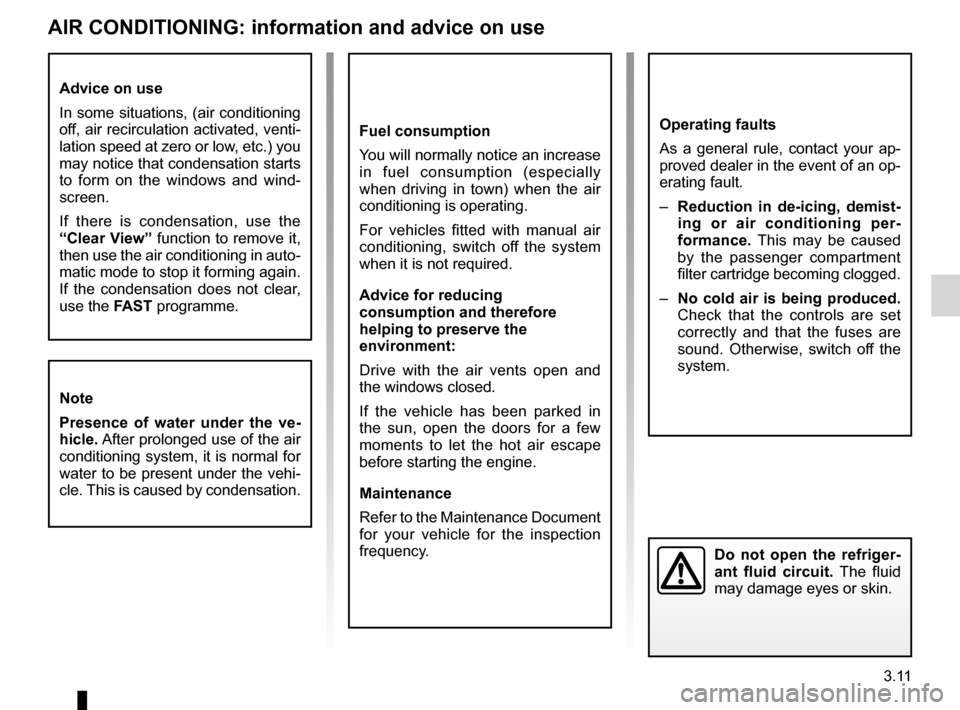
air conditioning ..................................... (up to the end of the DU)
heating and air conditioning system ...................... (current page)
air conditioning ..................................... (up to the end of the DU)
3.11
ENG_UD10101_2
Air conditionné : informations et conseils d’utilisation (X95 - B\
95 - D95 - Renault)
ENG_NU_891_892-7_L38-B32_Renault_3
Air conditioning: information and advice on use
AIR coNDITIoNINg: information and advice on use
Fuel consumption
You will normally notice an increase
in fuel consumption (especially
when driving in town) when the air
conditioning is operating.
For vehicles fitted with manual air
conditioning, switch off the system
when it is not required.
Advice for reducing
consumption and therefore
helping to preserve the
environment:
Drive with the air vents open and
the windows closed.
If the vehicle has been parked in
the sun, open the doors for a few
moments to let the hot air escape
before starting the engine.
Maintenance
Refer to the Maintenance Document
for your vehicle for the inspection
frequency.operating faults
As a general rule, contact your ap-
proved dealer in the event of an op-
erating fault.
– Reduction in de-icing, demist -
ing or air conditioning per -
formance. This may be caused
by the passenger compartment
filter cartridge becoming clogged.
– No cold air is being produced.
Check that the controls are set
correctly and that the fuses are
sound. Otherwise, switch off the
system.
Advice on use
In some situations, (air conditioning
off, air recirculation activated, venti-
lation speed at zero or low, etc.) you
may notice that condensation starts
to form on the windows and wind -
screen.
If there is condensation, use the
“clear View” function to remove it,
then use the air conditioning in auto-
matic mode to stop it forming again.
If the condensation does not clear,
use the FAST programme.
Do not open the refriger -
ant fluid circuit. The fluid
may damage eyes or skin.
Note
Presence of water under the ve -
hicle. After prolonged use of the air
conditioning system, it is normal for
water to be present under the vehi-
cle. This is caused by condensation.
Page 140 of 241
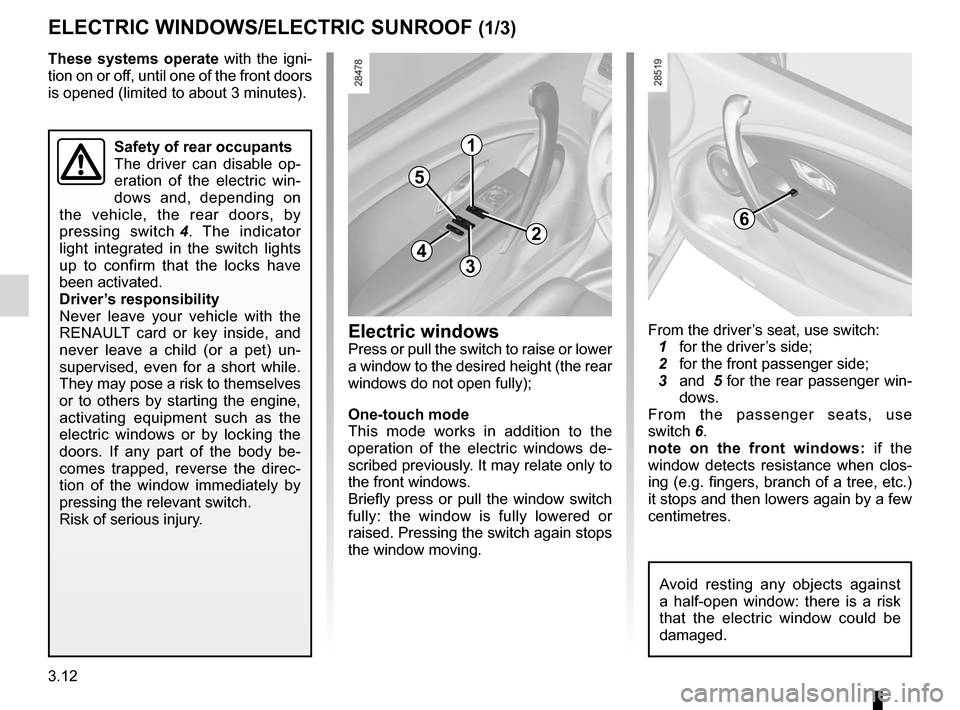
electric windows ................................... (up to the end of the DU)
child safety ............................................................. (current page)
children (safety) ..................................................... (current page)
sunroof .................................................. (up to the end of the DU)
3.12
ENG_UD21430_2
Lève-vitres électriques (L38 - X38 - Renault)
ENG_NU_891_892-7_L38-B32_Renault_3
Jaune NoirNoir texte
These systems operate with the igni -
tion on or off, until one of the front doors
is opened (limited to about 3 minutes).
From the driver’s seat, use switch:
1 for the driver’s side;
2 for the front passenger side;
3 and 5 for the rear passenger win-
dows.
From the passenger seats, use
switch 6.
note on the front windows: if the
window detects resistance when clos -
ing (e.g. fingers, branch of a tree, etc.)
it stops and then lowers again by a few
centimetres.
Electric windows/Electric sunroof
ElEcTRIc wINDowS/ElEcTRIc SuNRooF (1/3)
Electric windows
Press or pull the switch to raise or lower
a window to the desired height (the rear
windows do not open fully);
one-touch mode
This mode works in addition to the
operation of the electric windows de -
scribed previously. It may relate only to
the front windows.
Briefly press or pull the window switch
fully: the window is fully lowered or
raised. Pressing the switch again stops
the window moving.
1
2
34
5
6
Safety of rear occupants
The driver can disable op -
eration of the electric win -
dows and, depending on
the vehicle, the rear doors, by
pressing switch 4 . The indicator
light integrated in the switch lights
up to confirm that the locks have
been activated.
Driver’s responsibility
Never leave your vehicle with the
RENAULT card or key inside, and
never leave a child (or a pet) un -
supervised, even for a short while.
They may pose a risk to themselves
or to others by starting the engine,
activating equipment such as the
electric windows or by locking the
doors. If any part of the body be -
comes trapped, reverse the direc -
tion of the window immediately by
pressing the relevant switch.
Risk of serious injury.
Avoid resting any objects against
a half-open window: there is a risk
that the electric window could be
damaged.
Page 141 of 241
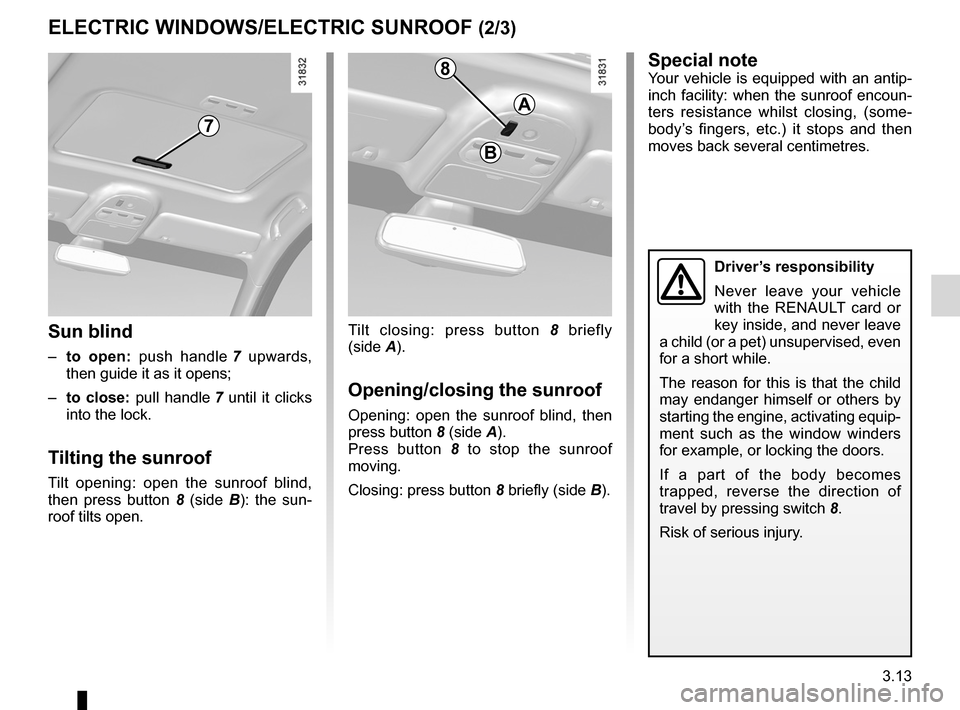
JauneNoirNoir texte
3.13
ENG_UD21430_2
Lève-vitres électriques (L38 - X38 - Renault)
ENG_NU_891_892-7_L38-B32_Renault_3
ElEcTRIc wINDowS/ElEcTRIc SuNRooF (2/3)
Tilt closing: press button 8 briefly
(side A).
opening/closing the sunroof
Opening: open the sunroof blind, then
press button 8 (side A).
Press button 8 to stop the sunroof
moving.
Closing: press button 8 briefly (side B).
Sun blind
– to open: push handle 7 upwards,
then guide it as it opens;
– to close: pull handle 7 until it clicks
into the lock.
Tilting the sunroof
Tilt opening: open the sunroof blind,
then press button 8 (side B ): the sun -
roof tilts open.
Special noteYour vehicle is equipped with an antip-
inch facility: when the sunroof encoun -
ters resistance whilst closing, (some -
body’s fingers, etc.) it stops and then
moves back several centimetres.
Driver’s responsibility
Never leave your vehicle
with the RENAULT card or
key inside, and never leave
a child (or a pet) unsupervised, even
for a short while.
The reason for this is that the child
may endanger himself or others by
starting the engine, activating equip-
ment such as the window winders
for example, or locking the doors.
If a part of the body becomes
trapped, reverse the direction of
travel by pressing switch 8.
Risk of serious injury.
7
8
B
A
Page 178 of 241
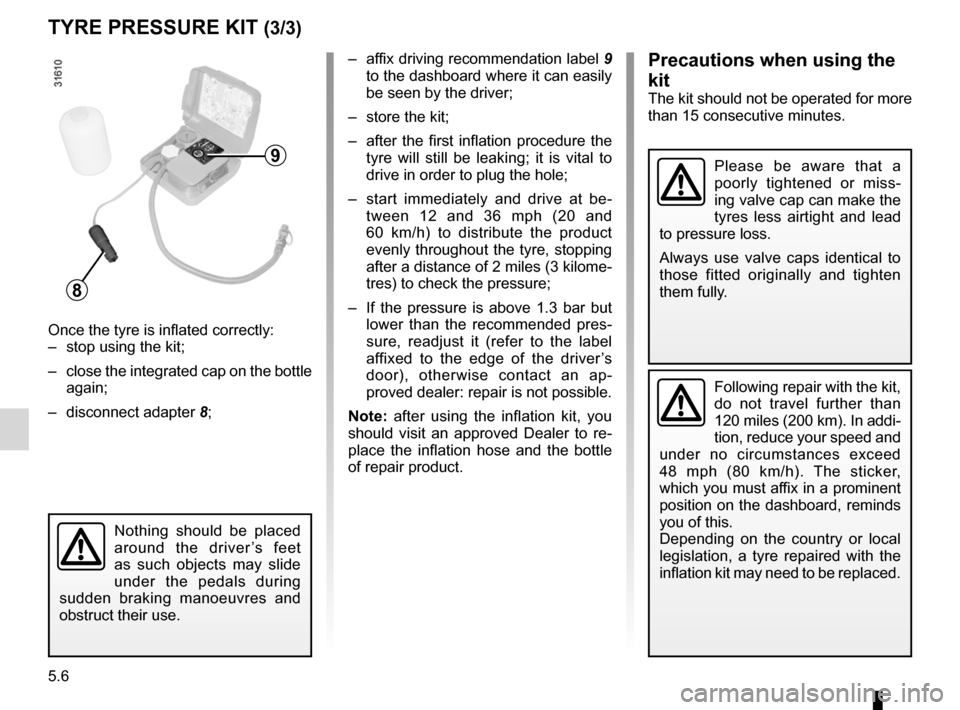
5.6
ENG_UD21559_4
Kit de gonflage (X95 - B95 - D95 - L38 - X38 - X32 - B32 - Renault)
ENG_NU_891_892-7_L38-B32_Renault_5
tyre Pressure KIt (3/3)
– affix driving recommendation label 9
to the dashboard where it can easily
be seen by the driver;
– store the kit;
– after the first inflation procedure the
tyre will still be leaking; it is vital to
drive in order to plug the hole;
– start immediately and drive at be -
tween 12 and 36 mph (20 and
60 km/h) to distribute the product
evenly throughout the tyre, stopping
after a distance of 2 miles (3 kilome-
tres) to check the pressure;
– If the pressure is above 1.3 bar but
lower than the recommended pres -
sure, readjust it (refer to the label
affixed to the edge of the driver ’s
door), otherwise contact an ap -
proved dealer: repair is not possible.
n ote: after using the inflation kit, you
should visit an approved Dealer to re -
place the inflation hose and the bottle
of repair product.Precautions when using the
kit
The kit should not be operated for more
than 15 consecutive minutes.
Nothing should be placed
around the driver ’s feet
as such objects may slide
under the pedals during
sudden braking manoeuvres and
obstruct their use.
9
8
Once the tyre is inflated correctly:
– stop using the kit;
– close the integrated cap on the bottle
again;
– disconnect adapter 8;
Following repair with the kit,
do not travel further than
120 miles (200 km). In addi -
tion, reduce your speed and
under no circumstances exceed
48 mph (80 km/h). The sticker,
which you must affix in a prominent
position on the dashboard, reminds
you of this.
Depending on the country or local
legislation, a tyre repaired with the
inflation kit may need to be replaced.
Please be aware that a
poorly tightened or miss -
ing valve cap can make the
tyres less airtight and lead
to pressure loss.
Always use valve caps identical to
those fitted originally and tighten
them fully.
Page 209 of 241
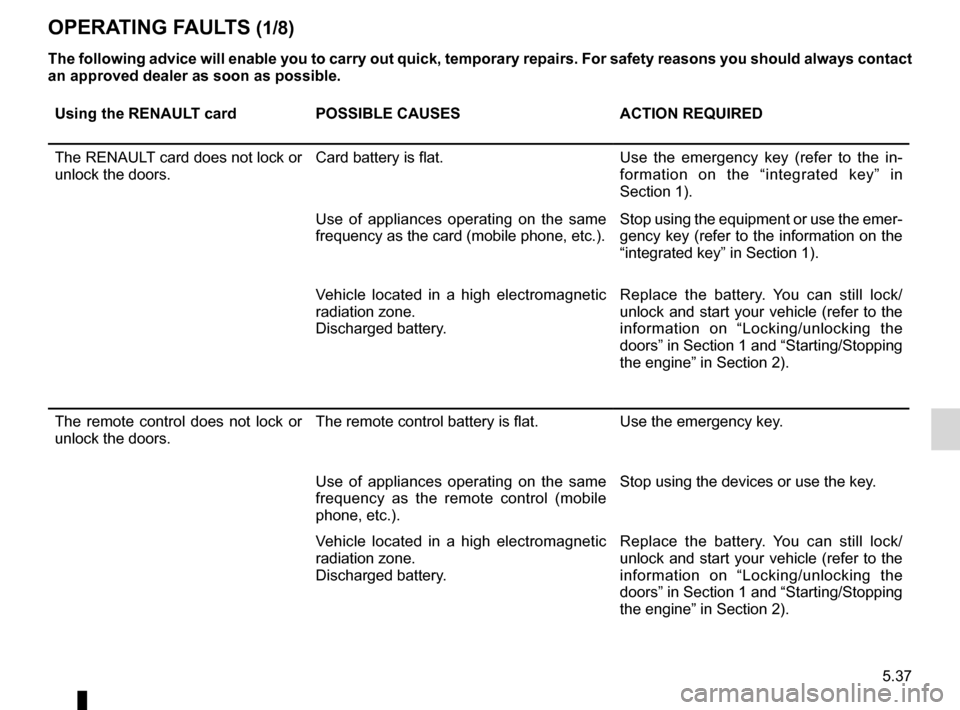
operating faults ..................................... (up to the end of the DU)
faults operating faults ............................... (up to the end of the DU)
5.37
ENG_UD17941_2
Anomalies de fonctionnement (X85 - L38 - X38 - Renault)
ENG_NU_891_892-7_L38-B32_Renault_5
Operating faults
OPeratIng F aults (1/8)
the following advice will enable you to carry out quick, temporary repairs. For safety reasons you should always contact
an approved dealer as soon as possible.
using the renault card POssIBle causes actIOn requIreD
The RENAULT card does not lock or
unlock the doors. Card battery is flat.
Use the emergency key (refer to the in-
formation on the “integrated key” in
Section 1).
Use of appliances operating on the same
frequency as the card (mobile phone, etc.). Stop using the equipment or use the emer-
gency key (refer to the information on the
“integrated key” in Section 1).
Vehicle located in a high electromagnetic
radiation zone.
Discharged battery. Replace the battery. You can still lock/
unlock and start your vehicle (refer to the
information on “Locking/unlocking the
doors” in Section 1 and “Starting/Stopping
the engine” in Section 2).
The remote control does not lock or
unlock the doors. The remote control battery is flat.
Use the emergency key.
Use of appliances operating on the same
frequency as the remote control (mobile
phone, etc.). Stop using the devices or use the key.
Vehicle located in a high electromagnetic
radiation zone.
Discharged battery. Replace the battery. You can still lock/
unlock and start your vehicle (refer to the
information on “Locking/unlocking the
doors” in Section 1 and “Starting/Stopping
the engine” in Section 2).
Page 211 of 241
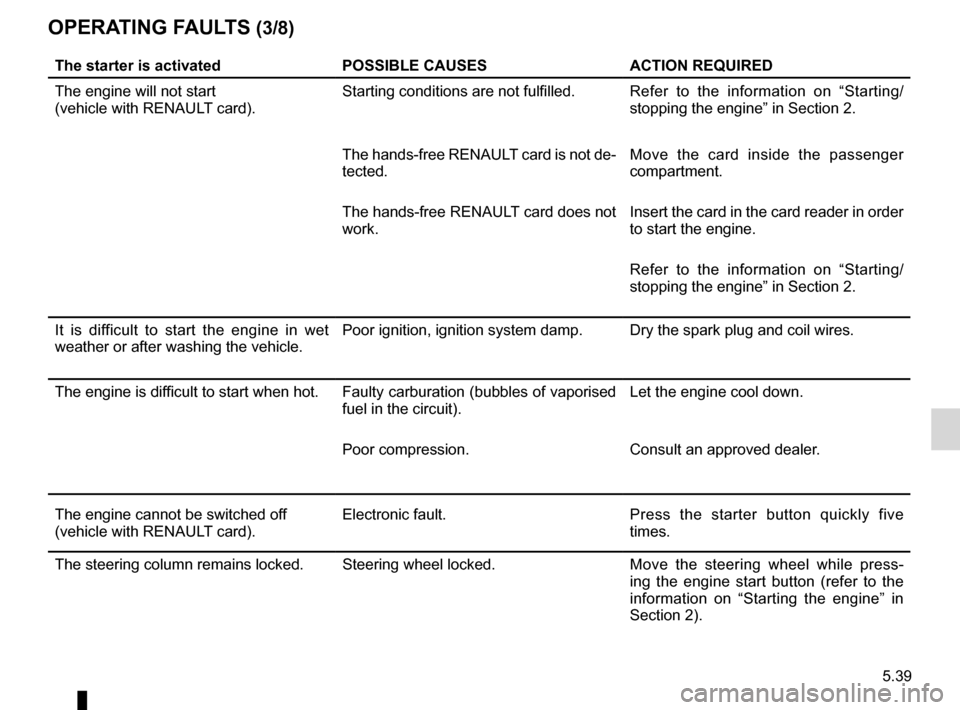
JauneNoirNoir texte
5.39
ENG_UD17941_2
Anomalies de fonctionnement (X85 - L38 - X38 - Renault)
ENG_NU_891_892-7_L38-B32_Renault_5
OPeratIng F aults (3/8)
the starter is activated POssIBle causesactIOn requIreD
The engine will not start
(vehicle with RENAULT card). Starting conditions are not fulfilled.
Refer to the information on “Starting/
stopping the engine” in Section 2.
The hands-free RENAULT card is not de-
tected. Move the card inside the passenger
compartment.
The hands-free RENAULT card does not
work. Insert the card in the card reader in order
to start the engine.
Refer to the information on “Starting/
stopping the engine” in Section 2.
It is difficult to start the engine in wet
weather or after washing the vehicle. Poor ignition, ignition system damp.
Dry the spark plug and coil wires.
The engine is difficult to start when hot. Faulty carburation (bubbles of vaporised
fuel in the circuit).Let the engine cool down.
Poor compression. Consult an approved dealer.
The engine cannot be switched off
(vehicle with RENAULT card). Electronic fault.
Press the starter button quickly five
times.
The steering column remains locked. Steering wheel locked.Move the steering wheel while press-
ing the engine start button (refer to the
information on “Starting the engine” in
Section 2).
Page 238 of 241
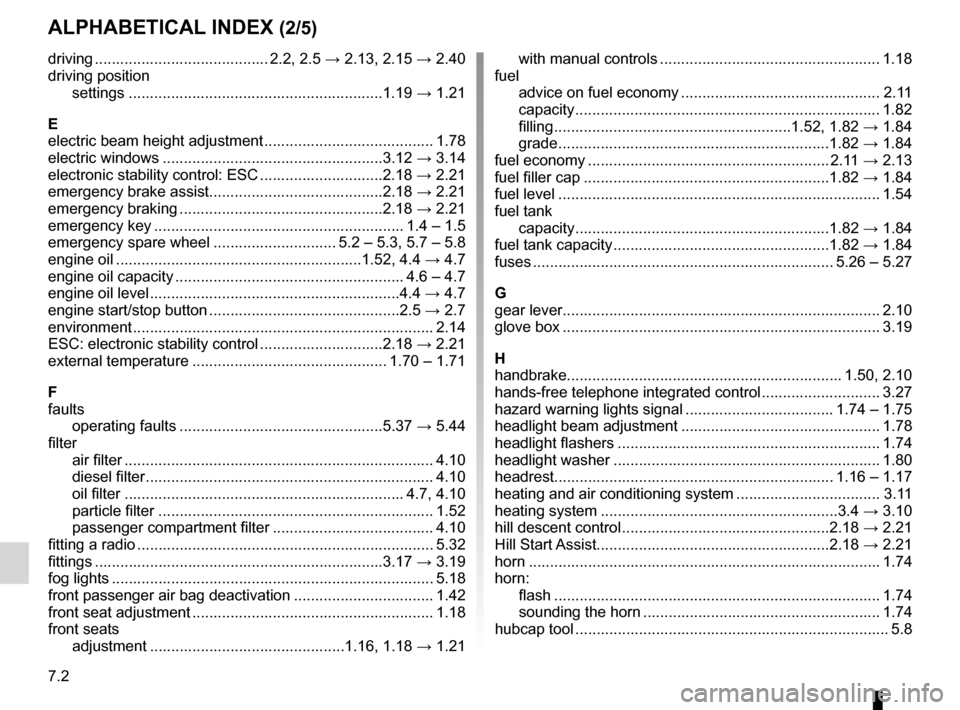
7.2
FRA_UD27191_7
Index (L38 - X38 - Renault)
ENG_NU_891_892-7_L38-B32_Renault_7
Jaune NoirNoir texte
AlphAbeticAl index (2/5)
driving ......................................... 2.2, 2.5 → 2.13, 2.15 → 2.40
driving position settings ............................................................ 1.19 → 1.21
e
electric beam height adjustment ........................................ 1.78
electric windows .................................................... 3.12 → 3.14
electronic stability control: ESC .............................2.18 → 2.21
emergency brake assist ......................................... 2.18 → 2.21
emergency braking ................................................ 2.18 → 2.21
emergency key ........................................................... 1.4 – 1.5
emergency spare wheel ............................. 5.2 – 5.3, 5.7 – 5.8
engine oil .......................................................... 1.52, 4.4 → 4.7
engine oil capacity ...................................................... 4.6 – 4.7
engine oil level ........................................................... 4.4 → 4.7
engine start/stop button ............................................. 2.5 → 2.7
environment ....................................................................... 2.14
ESC: electronic stability control .............................2.18 → 2.21
external temperature .............................................. 1.70 – 1.71
F
faults operating faults ................................................ 5.37 → 5.44
filter air filter ......................................................................... 4.10
diesel filter .................................................................... 4.10
oil filter .................................................................. 4.7, 4.10
particle filter ................................................................. 1.52
passenger compartment filter ...................................... 4.10
fitting a radio ...................................................................... 5.32
fittings .................................................................... 3.17 → 3.19
fog lights ........................................................................\
.... 5.18
front passenger air bag deactivation ................................. 1.42
front seat adjustment ......................................................... 1.18
front seats adjustment ..............................................1.16, 1.18 → 1.21 with manual controls
.................................................... 1.18
fuel advice on fuel economy ............................................... 2.11
capacity ........................................................................ 1.82
filling ........................................................ 1.52, 1.82 → 1.84
grade ................................................................ 1.82 → 1.84
fuel economy ......................................................... 2.11 → 2.13
fuel filler cap .......................................................... 1.82 → 1.84
fuel level ........................................................................\
.... 1.54
fuel tank capacity ............................................................ 1.82 → 1.84
fuel tank capacity ................................................... 1.82 → 1.84
fuses ....................................................................... 5.26 – 5.27
G
gear lever ........................................................................\
... 2.10
glove box ........................................................................\
... 3.19
h
handbrake ................................................................. 1.50, 2.10
hands-free telephone integrated control ............................ 3.27
hazard warning lights signal ................................... 1.74 – 1.75
headlight beam adjustment ............................................... 1.78
headlight flashers .............................................................. 1.74
headlight washer ............................................................... 1.80
headrest .................................................................. 1.16 – 1.17
heating and air conditioning system .................................. 3.11
heating system ........................................................ 3.4 → 3.10
hill descent control ................................................. 2.18 → 2.21
Hill Start Assist....................................................... 2.18 → 2.21
horn ........................................................................\
........... 1.74
horn: flash ............................................................................. 1.74
sounding the horn ........................................................ 1.74
hubcap tool ........................................................................\
.. 5.8
Page 240 of 241
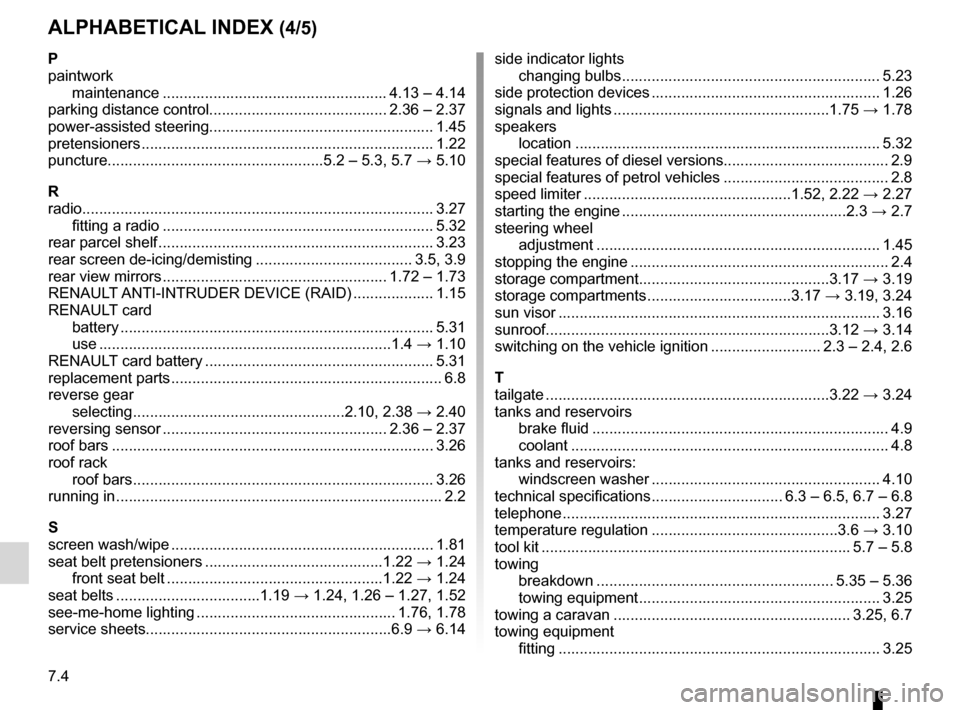
7.4
FRA_UD27191_7
Index (L38 - X38 - Renault)
ENG_NU_891_892-7_L38-B32_Renault_7
Jaune NoirNoir texte
AlphAbeticAl index (4/5)
p
paintwork
maintenance ..................................................... 4.13 – 4.14
parking distance control .......................................... 2.36 – 2.37
power-assisted steering ..................................................... 1.45
pretensioners ..................................................................... 1.22
puncture ................................................... 5.2 – 5.3, 5.7 → 5.10
R
radio........................................................................\
........... 3.27
fitting a radio ................................................................ 5.32
rear parcel shelf ................................................................. 3.23
rear screen de-icing/demisting ..................................... 3.5, 3.9
rear view mirrors ..................................................... 1.72 – 1.73
RENAULT ANTI-INTRUDER DEVICE (RAID) ...................1.15
RENAULT card battery .......................................................................... 5.31
use ..................................................................... 1.4 → 1.10
RENAULT card battery ...................................................... 5.31
replacement parts ................................................................ 6.8
reverse gear selecting .................................................. 2.10, 2.38 → 2.40
reversing sensor ..................................................... 2.36 – 2.37
roof bars ........................................................................\
.... 3.26
roof rack roof bars ....................................................................... 3.26
running in ........................................................................\
..... 2.2
S
screen wash/wipe .............................................................. 1.81
seat belt pretensioners .......................................... 1.22 → 1.24
front seat belt ...................................................1.22 → 1.24
seat belts .................................. 1.19 → 1.24, 1.26 – 1.27, 1.52
see-me-home lighting ............................................... 1.76, 1.78
service sheets .......................................................... 6.9 → 6.14side indicator lights
changing bulbs ............................................................. 5.23
side protection devices ...................................................... 1.26
signals and lights ................................................... 1.75 → 1.78
speakers location ........................................................................ 5.32
special features of diesel versions .......................................2.9
special features of petrol vehicles ....................................... 2.8
speed limiter ................................................. 1.52, 2.22 → 2.27
starting the engine ..................................................... 2.3 → 2.7
steering wheel adjustment ................................................................... 1.45
stopping the engine ............................................................. 2.4
storage compartment ............................................. 3.17 → 3.19
storage compartments .................................. 3.17 → 3.19, 3.24
sun visor ........................................................................\
.... 3.16
sunroof ................................................................... 3.12 → 3.14
switching on the vehicle ignition .......................... 2.3 – 2.4, 2.6
t
tailgate ................................................................... 3.22 → 3.24
tanks and reservoirs brake fluid ...................................................................... 4.9
coolant ........................................................................... 4.8
tanks and reservoirs: windscreen washer ...................................................... 4.10
technical specifications ............................... 6.3 – 6.5, 6.7 – 6.8
telephone ........................................................................\
... 3.27
temperature regulation ............................................ 3.6 → 3.10
tool kit ........................................................................\
. 5.7 – 5.8
towing breakdown ........................................................ 5.35 – 5.36
towing equipment ......................................................... 3.25
towing a caravan ........................................................ 3.25, 6.7
towing equipment fitting ............................................................................ 3.25